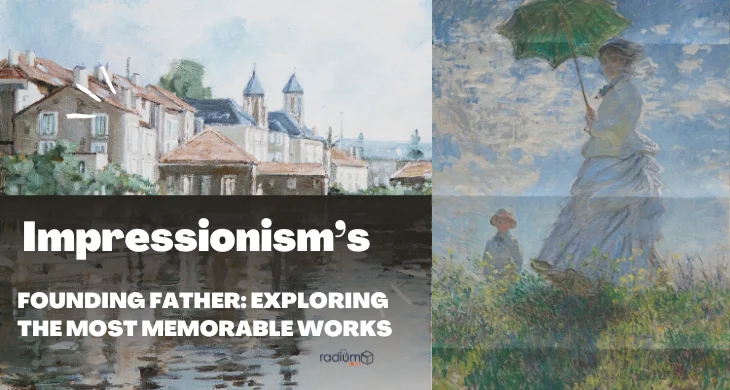Impressionism stands out as a pivotal art movement that reshaped the course of artistic expression. Emerging in France during the late 1800s, Impressionism revolutionized the way artists depicted scenes by focusing on capturing the transient interplay of light and color. Departing from the rigid conventions of academic painting prevalent at the time, Impressionist artists embraced spontaneity and sought to convey the essence of a moment rather than meticulously rendering details. This departure from tradition sparked controversy initially but ultimately paved the way for the emergence of modern art. Impressionism’s emphasis on capturing fleeting impressions and subjective interpretations laid the foundation for subsequent artistic movements, influencing generations of artists and reshaping the trajectory of art history.
Origins and Development of Impressionism
Impressionism blossomed during the 1860s and 1870s, heralding a departure from the established norms of academic art. Dissatisfied with the formalities and restrictions of traditional studio painting, a cohort of forward-thinking artists, led by luminaries like Claude Monet, Pierre-Auguste Renoir, and Edgar Degas, rebelled against convention. They yearned to embrace the spontaneity and vitality of the world around them, venturing outdoors to paint en plein air, or “in the open air.” This shift marked a profound departure from the controlled environments of the studio, allowing artists to immerse themselves in nature and capture its ever-changing light and atmosphere.
By abandoning the meticulous detailing and precise rendering favored by academic painters, Impressionists aimed to convey the immediacy and sensory experience of a moment. Their brushstrokes became bolder and more expressive, reflecting the play of light and color in a way that felt dynamic and alive. Rather than depicting scenes with strict adherence to reality, Impressionist artists prioritized capturing the essence and mood of a scene, often opting for unconventional compositions and perspectives.
Initially met with skepticism and criticism from the conservative art establishment, Impressionism gradually gained acceptance and appreciation. Its bold experimentation and innovative techniques paved the way for artistic freedom and laid the groundwork for subsequent movements like Post-Impressionism and Modernism. Today, Impressionism remains celebrated for its revolutionary approach to painting and its enduring influence on the trajectory of art history.
Key Characteristics of Impressionist Art

Use of Light and Color
Impressionist artists boldly departed from the somber, subdued color palette favored by academic painters, opting instead for vibrant and luminous hues. Their goal was to faithfully capture the dynamic interplay of light and color in the natural world, a task that led many to venture outdoors and paint en plein air. By immersing themselves in the open air, these artists could observe firsthand the fleeting effects of sunlight on landscapes, seascapes, and cityscapes alike.
With their keen observation and mastery of color theory, Impressionists skillfully translated the dazzling array of hues found in nature onto their canvases. They embraced bold, spontaneous brushwork to convey the shimmering quality of light and the subtle shifts in color that characterize different times of day and weather conditions. Through their innovative techniques, Impressionists sought to evoke not just a visual representation of the world, but also the sensory experience of being immersed in it.
This departure from convention sparked controversy and criticism among more conservative art circles, but it also heralded a new era of artistic expression and freedom. Today, the vivid colors and dynamic compositions of Impressionist paintings continue to captivate audiences worldwide, serving as a testament to the enduring allure of capturing the essence of light and color on canvas.
Loose Brushwork
Impressionist painters embraced a bold and energetic approach to their craft, utilizing swift and unrestrained brushstrokes to infuse their artworks with a sense of vitality and motion. Rather than meticulously rendering every detail, they prioritized capturing the essence and atmosphere of a scene in a single, fleeting moment. This technique, known as “alla prima” or “wet-on-wet” painting, enabled artists like Claude Monet and Edgar Degas to imbue their works with spontaneity and immediacy.
By working quickly and decisively, Impressionists could convey the ever-changing nature of light and movement, whether depicting bustling city streets, serene landscapes, or bustling social gatherings. This rapid and gestural style allowed them to evoke a sense of dynamism and energy, inviting viewers to experience the scene as if they were witnessing it firsthand.
The emphasis on capturing the essence of a moment rather than achieving photographic realism was a revolutionary departure from traditional academic painting techniques. It liberated artists from the constraints of conventional representation, paving the way for new forms of artistic expression and paving the way for the emergence of modern art movements in the years to come.
Depiction of Everyday Scenes

Impressionist artists diverged from the traditional focus on monumental historical or mythological subjects, opting instead to portray the ordinary moments of contemporary existence. They found inspiration in the bustling energy of urban life, capturing the lively interactions on busy city streets and the rhythm of everyday activities. Additionally, Impressionists sought solace in the tranquility of natural landscapes, depicting serene scenes of countryside vistas, blooming gardens, and shimmering bodies of water.
Moreover, these artists delved into the intimate spaces of domestic life, portraying the quiet moments of solitude and connection within the home. Through their paintings, they celebrated the beauty found in the simplicity of everyday routines, elevating the mundane to the realm of art. By shifting their focus to the immediacy of the present moment, Impressionists brought a new sense of realism and authenticity to their works, inviting viewers to connect with the ordinary moments that shape our lives. This emphasis on capturing the essence of contemporary life was a radical departure from the grand narratives of the past, marking a pivotal moment in the evolution of artistic expression.
Famous Impressionist Artists
Claude Monet
Claude Monet stands out as one of the most renowned figures in the Impressionist movement, celebrated for his captivating depictions of everyday scenes infused with vibrant colors and dynamic light. His iconic series of paintings, including those featuring water lilies, haystacks, and the Rouen Cathedral, exemplify his unparalleled mastery of capturing the essence of the French countryside.
Monet’s unique artistic style revolutionized the way artists approached the representation of nature, as he eschewed the traditional rules of academic painting in favor of spontaneity and innovation. With his bold brushstrokes and keen observation of light and shadow, Monet created immersive landscapes that transport viewers to the heart of the scene.
Through his water lily paintings, Monet explored the interplay of light and reflection on the surface of tranquil ponds, inviting viewers to experience the serene beauty of nature. Similarly, his depictions of haystacks at different times of the day showcased his unparalleled ability to capture the ever-changing nuances of light.
Furthermore, Monet’s series of paintings featuring the Rouen Cathedral demonstrate his fascination with capturing the shifting effects of light on architectural forms. By portraying the cathedral in various atmospheric conditions, from bright sunlight to misty haze, Monet showcased his mastery of capturing the transient nature of light and its transformative impact on the landscape.
Pierre-Auguste Renoir
Pierre-Auguste Renoir’s artistic legacy is characterized by his delightful use of color and his ability to capture the simple pleasures of daily existence. Renowned for his portraits and depictions of leisure activities, Renoir infused his artworks with a sense of warmth and intimacy that resonates with viewers.
Renoir’s paintings often feature lively scenes of people enjoying leisurely pursuits such as picnics, dancing, and strolls in the park. Through his vibrant palette and expressive brushwork, he conveyed the joy and spontaneity of these everyday moments, inviting viewers to share in the exuberance of his subjects.
One of Renoir’s distinctive traits was his emphasis on capturing the human form with a soft, luminous quality. His portraits radiate a sense of warmth and humanity, as he skillfully rendered the delicate nuances of facial expressions and gestures. Renoir’s subjects exude a sense of contentment and vitality, reflecting his optimistic outlook on life.
In addition to his portrayal of leisure activities, Renoir also excelled in depicting the natural beauty of outdoor settings. His landscapes often feature lush gardens, sun-dappled meadows, and tranquil riversides, imbuing his compositions with a sense of serenity and harmony.
Renoir’s paintings celebrate the simple joys of existence and convey a timeless message of optimism and human connection. His works continue to inspire and uplift audiences, serving as a testament to the enduring power of art to capture the essence of life.
Edgar Degas
Edgar Degas is celebrated for his captivating artworks that vividly portray scenes from the vibrant life of 19th-century Paris. Best known for his mesmerizing depictions of ballet dancers, Degas had a remarkable ability to capture the grace, elegance, and dynamism of the dancers in motion.
One of Degas’s most iconic subjects was the world of ballet, which he explored in depth through his paintings, drawings, and sculptures. His keen observation skills allowed him to depict the intricate movements and delicate gestures of the dancers with remarkable precision and sensitivity.
In addition to his ballet scenes, Degas also depicted other aspects of Parisian life, including horse races, café scenes, and everyday activities. His works offer a fascinating glimpse into the bustling streets and bustling social milieu of Belle Époque Paris.
What set Degas apart as an artist was his innovative approach to composition and perspective. He often experimented with unusual viewpoints and dramatic angles, creating dynamic compositions that draw the viewer into the heart of the action.
Degas’s legacy continues to inspire artists and art enthusiasts around the world, his pioneering contributions to the Impressionist movement, and his enduring impact on the art world. His ability to capture the essence of movement and emotion in his works remains unparalleled, cementing his place as one of the most influential artists of his time.
Camille Pissarro
Camille Pissarro played a pivotal role in shaping the Impressionist movement with his remarkable landscapes and urban scenes. His paintings are characterized by their vibrant colors, loose brushwork, and emphasis on capturing the fleeting effects of light.
As one of the founding members of the Impressionist group, Pissarro was instrumental in guiding and nurturing the talents of younger artists who were drawn to the movement’s innovative approach. He served as a mentor and friend to artists like Paul Cézanne and Paul Gauguin, offering them invaluable advice and encouragement.
Pissarro’s artistic vision was deeply rooted in his appreciation for nature and the rural landscapes of France. He often painted en plein air, or outdoors, allowing him to immerse himself in the sights and sounds of the countryside.
In addition to his landscapes, Pissarro also depicted scenes of everyday life in bustling cities like Paris. His paintings captured the energy and vitality of urban existence, portraying bustling streets, bustling markets, and bustling cafés with remarkable authenticity.
Pissarro’s legacy as an Impressionist master continues to inspire artists and art lovers alike. His dedication to capturing the beauty of the natural world and his commitment to artistic innovation have left an indelible mark on the history of art.
Impressionism’s Impact on Art
Impressionism’s impact reverberated far beyond its own time, shaping the course of art history for decades to come. The movement’s revolutionary approach to capturing the essence of light and color laid the groundwork for a host of new artistic styles and movements.
One of the most notable offshoots of Impressionism was Post-Impressionism, which emerged in the late 19th century and sought to push the boundaries of artistic expression even further. Artists like Vincent van Gogh and Paul Cézanne, who were influenced by Impressionism, experimented with bold colors, expressive brushwork, and innovative compositions, paving the way for the modernist art movements of the 20th century.
Fauvism, another movement inspired by Impressionism, emerged in the early 20th century and embraced vivid colors and simplified forms to convey emotion and sensation. Led by artists like Henri Matisse and André Derain, Fauvism rejected naturalistic representation in favor of subjective interpretation, ushering in a new era of artistic freedom and experimentation.
Cubism, pioneered by Pablo Picasso and Georges Braque, was yet another movement indebted to the innovations of Impressionism. Cubist sought to deconstruct traditional forms, perspectives and depicting objects from multiple viewpoints simultaneously. This radical approach to representation challenged conventional notions of space and form, paving the way for abstract art and the avant-garde movements of the 20th century.
Conclusion
Impressionism remains one of the most beloved and influential art movements in history, celebrated for its innovative approach to capturing the beauty of the natural world. Its legacy continues to inspire artists and art lovers around the world, reminding us of the power of light, color, and spontaneity in art.
FAQs
Ques. What inspired the Impressionist artists?
Ans. Impressionist artists drew inspiration from nature and sought to capture the fleeting effects of light and color in their work.
Ques. How did Impressionism influence modern art?
Ans. Impressionism laid the groundwork for modern art movements by challenging traditional artistic conventions and emphasizing spontaneity and subjective interpretation.
Ques. Who were some of the key figures of the Impressionist movement?
Ans. Claude Monet, Pierre-Auguste Renoir, Edgar Degas, and Camille Pissarro were among the leading figures of the Impressionist movement.
Ques. What are some famous examples of Impressionist paintings?
Ans. Some famous examples of Impressionist paintings include Claude Monet’s “Water Lilies,” Pierre-Auguste Renoir’s “Luncheon of the Boating Party,” and Edgar Degas’s “The Dance Class.”




